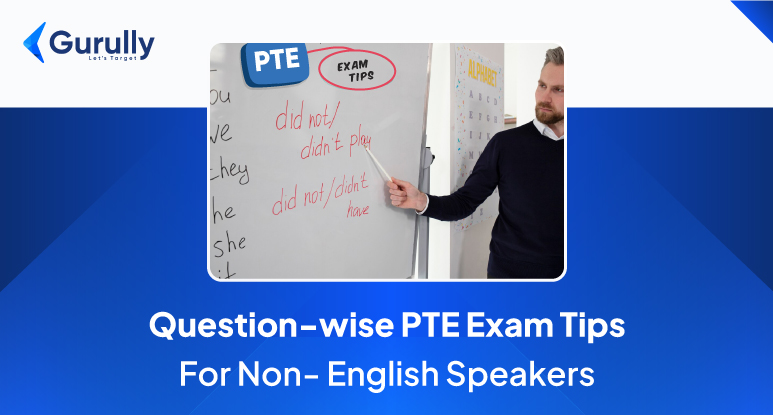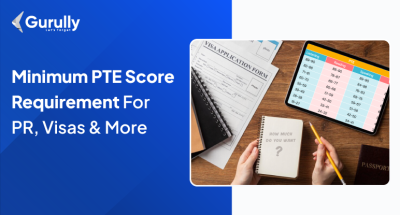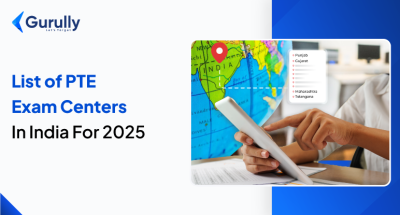The Pearson Test of English, PTE exam is gaining popularity all over the world. The exam is comparatively easy to approach and is accepted by many countries for work and education purposes. In this exam, your English language proficiency is being tested. It might sound easy, but non-English speakers need to practice PTE Exam to boost their confidence. But fear not, as we have cracked the secret of clearing the exam. Here are in-depth PTE exam preparation tips.
This blog is your guide, packed with tips to help you excel in all four PTE sections: Reading, Writing, Listening, and Speaking, and how to prepare for all question types.
PTE Exam Preparation Tips For Speaking & Writing Section :
Read Aloud:
- Make reading English aloud a daily habit.
- Begin with short, simple sentences and progressively increase complexity.
- Focus on pronouncing words precisely and sounding good.
- Practice using natural rhythm and proper dialect for a smooth delivery.
- Utilize resources like children’s books or language learning apps to find engaging practice texts. You can start from basic.
Repeat Sentence:
- Listen to short English sentences and repeat them.
- Use language learning apps or videos with subtitles.
- Start slow and gradually increase difficulty.
Describe Image:
- Practice with simple pictures.
- Start with basic: what you see, colors, and main objects.
- Use simple sentences and gradually add details.
- Find online resources with images and descriptions for practice.
Re-tell Lecture:
- Find short, easy-to-understand videos or audio recordings.
- Listen or watch, then summarize the key ideas in your own words.
- Start with videos that have subtitles.
- Gradually progress to videos without subtitles as your comprehension improves.
- Use resources like TED-Ed and educational YouTube channels.
Answer Short Question:
- Read simple English articles or watch educational videos to build general knowledge.
- Practice answering basic questions about everyday topics to see what you’ve retained.
- Use flashcards with common questions and answers to solidify your knowledge.
Summaries Written Text:
- Begin with easy texts to identify the main point.
- Use your own words and ensure your summary is accurate and grammatically correct.
Essay:
- Focus on short essays covering common themes.
- Build a strong foundation with an introduction, body paragraphs, and a conclusion.
- Begin with basic structures and smoothly integrate more complex sentences as you progress.
- Explore websites offering PTE essay topics to fuel your writing practice.
Write an Email (PTE Core):
- Don’t skim! Identify key details like recipient, purpose, and required information.
- Briefly jot down key points you need to address in the email.
- Plan a clear opening (greeting), body (main message), and closing
Respond to a Situation (PTE Core):
- Follow a simple structure like an Introduction (summarizing the situation), Key Points (elaborating on important details), Resolution (suggesting solutions/actions), and Closing (concluding and inviting further discussion).
- Take advantage of the ability to take notes during the listening phase. Jot down key points to structure your response effectively.
- Speak confidently and positively, even if you encounter minor stumbles.
PTE Exam Preparation Tips For Reading Section:
Reading & Writing: Fill In The Blanks:
- Move beyond just reading fill-in-the-blanks. Focus on choosing words that fit the sentence’s meaning and grammatical structure.
- Continuous language exercise strengthens your understanding of how grammar functions within a specific context.
- Improve your vocabulary while solidifying your grasp of grammatical rules.
Multiple Choice Multiple Answer:
- Read short English articles followed by answering questions to check your understanding.
- Begin with simpler texts and progressively challenge yourself with more complex articles.
- Practice your skill in identifying the central message of each article.
- Practice pinpointing important supporting details within the text
Re-order Paragraphs:
- Practice arranging basic sentences into a clear and logical paragraph.
- Identify relationships between ideas and use transition words to create a smooth flow.
- Begin with short, easy-to-understand texts and gradually tackle more complex paragraphs.
Fill In The Blanks:
- Learn new words and practice using them in context.
- Read simple texts and try to guess missing words before options appear.
- Focus on understanding the overall meaning of the sentence, not just individual words.
Multiple Choice, Single Answer:
- Identify all options supported by the passage.
- Focus on comprehending the central idea of the text.
- Select options with details that the reading material can back up.
Practice this PTE reading tips to score high and get a
PTE Exam Preparation Tips For Listening Section:
The PTE listening tips below will help you score high and achieve your dream score.
Summaries Spoken Text:
- Begin with short, easy audio recordings and work towards more complex content as your comprehension improves.
- Train yourself to identify the central theme of each recording. This is the foundation of any good summary.
- Pay close attention to the speaker. Anticipate transitions and shifts in the information presented.
- Find resources with short audio recordings and summaries. Actively listen, then compare your understanding to the provided summary.
Multiple-Choice (Choose Multiple Option):
- Start with bite-sized talks or conversations. This manageable length allows you to focus on understanding the core content.
- Go beyond just hearing. Engage with the audio by actively trying to grasp the key points and supporting details.
- After listening, dive into the questions. These act as your guide, prompting you to identify specific details within the audio.
- As your skills improve, gradually increase the length and complexity of the audio you listen to. This keeps challenging your comprehension muscles.
- Expose yourself to diverse topics and speakers. This broadens your understanding of natural speech patterns and accents.
Fill In The Blanks:
- Begin with recordings spoken at a slower pace. This allows you to grasp the fundamentals of the audio and build confidence.
- Pay close attention to the overall situation and topic being discussed. This will help you predict missing words and understand the flow of the conversation.
- Focus on identifying important words and phrases. These will act as anchors, allowing you to fill in the gaps and comprehend the speaker’s message.
- Many resources offer audio exercises with adjustable difficulty. Take advantage of these options to personalize your training.
Highlight Correct Summary (PTE Academic):
- Immerse yourself in short audio recordings.
- Train your ear to identify the central theme of each recording.
- Pay close attention to specific points that support the main idea.
- Craft a concise summary capturing the essence of the recording.
- Analyze the provided summaries and select the one that best aligns with your understanding and the recording’s content.
Multiple Choice (Choose Single Answer):
- Train your ears to zero in on the central message of each audio clip. What’s the core takeaway?
- Don’t just listen passively. Focus on pinpointing specific details that support the main idea.
- Prepare for questions that test your comprehension. Anticipate questions about the main idea and key supporting details.
- Similar to reading, you’ll be presented with answer choices. Based on the main idea and key details, select the option that best reflects the recording’s content.
- The more audio clips you listen to, the better you’ll become at identifying the main idea and key details. Find practice materials online or in PTE prep resources.
Select Missing World:
- Dive into short audio recordings, paying close attention to the overall conversation or situation.
- Analyze the flow of the conversation and the ideas being expressed to understand the sentence’s intended meaning.
- Use contextual clues to predict the missing word that would logically complete the sentence and contribute to the overall message.
- Consider synonyms, grammatical structure, and the surrounding words to identify the most likely missing word.
- If offered multiple options for the missing word, evaluate each choice in the context of the sentence and choose the one that best fits the meaning.
Highlight Incorrect Words:
- Pair audio recordings with their transcripts to supercharge your listening skills.
- Pay close attention as you listen, immersing yourself fully in the recording.
- Follow along with the transcript while listening, connecting the spoken word and written text.
- Train your ear to identify deviations between what you hear and read.
Write From Dictation:
- Begin with easy-to-understand sentences to build a solid foundation.
- As you gain confidence, progressively challenge yourself with more intricate sentence structures.
- Pay close attention to how each sentence is spoken, focusing on pronunciation and rhythm.
- Accurately transcribe what you hear, ensuring your written version flawlessly reflects the spoken sentence.
- Pay close attention to grammar rules while writing, ensuring proper sentence formation and punctuation.
- Develop a keen eye for detail and meticulously check your writing for any spelling errors.
- This exercise improves your listening comprehension and strengthens your writing mechanics.
Prepare for PTE in 7 Days.
Additional PTE Exam Preparation Tips
- Surround Yourself With English Language: Make English your daily soundtrack! Watch shows and movies you love, blast catchy tunes, and try to think in English whenever possible. The more you surround yourself with the language, the more comfortable you’ll become.
- Join Language Classes: Structured learning is your superpower! Consider an English class for a solid grammar, vocabulary, and pronunciation foundation. Bonus: practice speaking with classmates and get teacher feedback to polish your skills.
- Seek Feedback: Don’t be shy – ask for help! Feedback from teachers, friends, or language exchange partners is gold. It pinpoints areas you can improve and guides your practice. Remember, mistakes are stepping stones – embrace them and learn from them!
- Stay Motivated & Eager: Learning a language is a marathon, not a sprint. Stay pumped by celebrating your achievements, big or small. Keep your goals and reasons for learning English in mind. Persistence is key – don’t let setbacks slow you down! You’ve got this!
To Achieve Your Dream Score – Take the PTE Mock Test!
One of the most important PTE exam preparation tips is practicing on mock tests. here are the reasons why you must consider it.
- Exam Practice & Familiarity: Mock tests allow you to practice under timed conditions, similar to the real PTE. This helps you manage your time effectively and develop strategies for tackling different question types within the allotted time frame.
- Identifies Weaknesses & Strengths: Feedback reports generated after mock tests pinpoint your strengths and weaknesses in each section. This allows you to focus your study efforts on areas that require more work and capitalize on your existing strengths.
- Boosts Confidence: Performing well on a mock test can significantly boost your confidence and reduce test anxiety. Knowing you can handle the pressure and format of the real exam goes a long way in achieving peak performance on test day.
- Identifies Test-Taking Strategies: Mock tests provide an opportunity to experiment with different test-taking strategies and see what works best for you. This allows you to fine-tune your approach to each section and maximize your score on the actual exam.
- Helps In Understanding Test: Mock tests mimic the real PTE exam format, including speaking, writing, reading, and listening sections. A mock test gives you a realistic idea of your current level and identifies areas needing improvement before the exam.
These are all things you can get at Gurully’s practice platform. We provide students with full-length mock tests for PTE test preparation. Our platform will help you achieve your dream by providing authentic practice material and the latest prediction file. You can follow us on social media to enhance the English language for your PTE exam.
Our platform provides both PTE Academic preparation and PTE Core practice material. Even if your exam is near and you want to do a final practice, you can opt for our 5-day plan. Our scoring is AI-powered, so you get instant results. With real-time exam simulation, you will learn how the actual exam will be, and it will help reduce last-minute stress.
Conclusion:
Acing the PTE exam hinges on a strategic, well-rounded study plan incorporating all four testing sections: speaking, writing, reading, and listening. By diligently practicing each section with the help of online resources and PTE exam tips, you’ll be well-equipped to reach your target score. Identify your areas of weakness and dedicate focused practice time to shore them up. Conversely, leverage your strengths by using them as a springboard to tackle more challenging tasks.
Remember, consistent exposure to English is one of the most important PTE exam preparation tips . Immerse yourself in the language through movies, music, and even internal dialogue. Don’t be afraid to think in English throughout your day-to-day activities. Embrace feedback from teachers, classmates, or language exchange partners. View mistakes as valuable learning opportunities, not setbacks. With unwavering dedication, a positive mindset, and a strategic study plan, you’ll face the PTE exam feeling confident and prepared to conquer it.
Also Read:







